
The international conference on E-Assessment in Mathematical Sciences (EAMS) is a three-day academic conference organised by Newcastle University taking place 28th – 30th August 2018.
Building on the success of EAMS 2016, the conference aims to bring together researchers and practitioners with an interest in e-assessment for mathematics and the sciences, with an emphasis on enabling attendees to have a go at creating material, and getting an opportunity to share expertise directly. It will consist of a mix of presentations of new techniques, and pedagogic research, as well as live demos and workshops where you can get hands-on with leading e-assessment software.
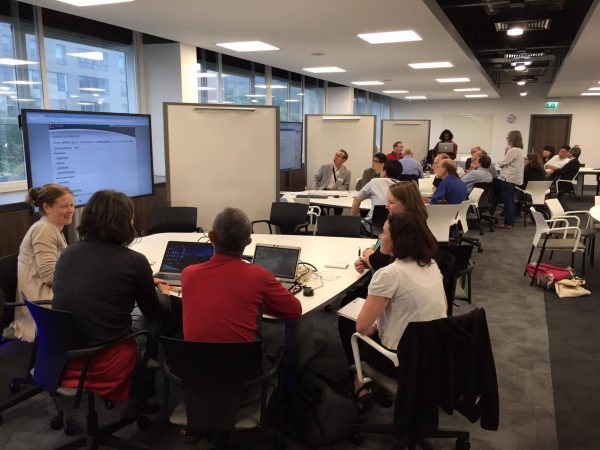
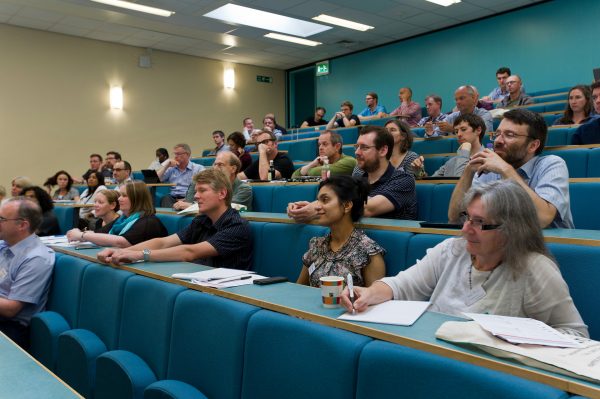
Over three days, EAMS 2018 will comprise a mix of talks and hands-on activities:
- Developer updates from the people responsible for popular mathematical e-assessment systems, detailing the latest features.
- Lightning talks on a variety of topics to do with e-assessment in mathematical disciplines.
- Hands-on workshops led by experts in a variety of e-assessment systems.
- Live demos led by experts in the field.
- Code sprints with the aim of adding features to systems, writing documentation, or creating material on a particular topic.
Compared to EAMS 2016, the emphasis this time is much more on enabling attendees to have a go at creating material, and getting an opportunity to share expertise directly.
The call for talk and workshop proposals is currently open. If you have some research or an innovative technique related to mathematical e-assessment that you would like to present, EAMS 2018 is the perfect venue. The deadline for talk proposals is May 31st.
The conference fee is only £75 and includes a conference dinner. You can find out more about EAMS, as well as the forms to register for the conference and propose a talk, at the conference website, eams.ncl.ac.uk.
During our project to create material for students making the transition to university, I did a bit of development work on Numbas based on issue that our interns raised. I’ll describe those here. Read the rest
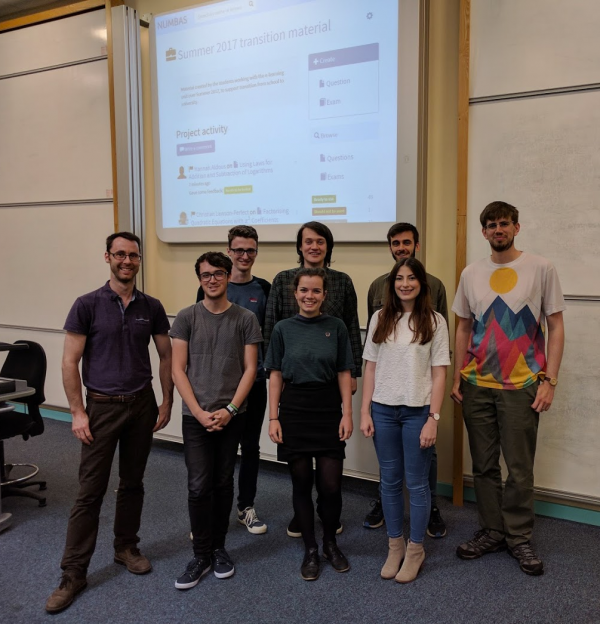
This Summer we’ve supervised a group of student interns creating a bank of Numbas questions to support students making the transition from school to university. The genus of the project was the realisation that many degree courses around the university require a level of mathematical ability that students don’t expect when they apply, and might have lost in the years since GCSE. We aimed to create a bank of practice material that students can be directed to, following diagnostic tests or visits to our maths support service at the start of the academic year.
Bradley, Lauren, Stanislav, Aiden, Elliott and Hannah have done a sterling job, creating over 150 questions in six weeks, covering topics mainly at the English GCSE level (exams taken at age 16, and many students’ last encounter with formal maths). Read the rest
The sigma network is hosting a free workshop hosted by the Mathematics Resource Centre, University of Bath on Thursday 31st August, 10:30-16:30.
This event will provide:
- a hands-on introduction to Numbas, including logging on to the mathcentre editor, selecting questions to make tests, and writing your own questions.
- a resource swap shop. Opportunity for all delegates to share information on a resource they use.
- information about using Numbas to fill the gaps in mathcentre.
There’s more information on the event’s page on the sigma website.
Bill Foster was director of the e-learning unit at Newcastle University until his retirement in 2016. In this post he tells the story of how Numbas came to be developed under his guidance.
Numbas is the latest in a long line of assessments systems: it is the spiritual successor at Newcastle to the i-assess assessment system which itself was based on the CALM system developed in the late 1980s.
In the following I will cover the implementation of CALM at Brunel University (1991/2), and at Newcastle University the implementation of i-assess (2006) followed by the development and implementation of Numbas (2012). Read the rest
In this series of posts, we’re highlighting questions we’ve found on the public Numbas editor which do something innovative or are of particularly high quality.
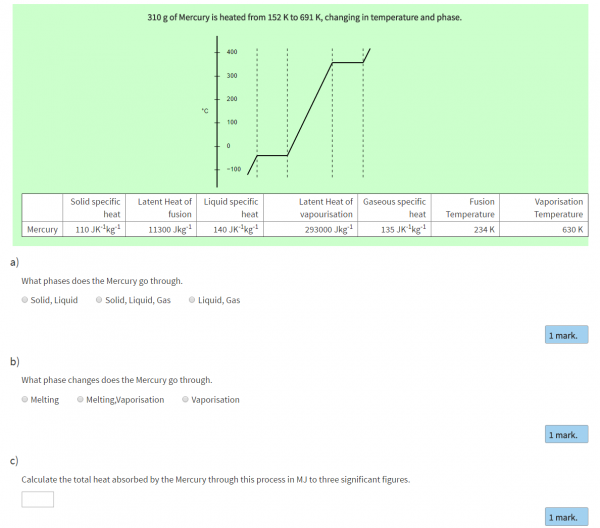
This question by Dr. Tom Stallard of the University of Leicester asks students to interpret a graph showing the temperature of a material as it is heated. The graph is dynamically generated using the JSXGraph extension, and a table shows some of the physical properties of the material.
While quite a simple question pedagogically, I like how the dynamic graph in this question displays information to the student in an intuitive format.
We asked Tom how he uses Numbas in his teaching:
I am an Associate Professor of Planetary Astronomy at Leicester. I use Numbas for the College of Science and Engineering Foundation Year, teaching the module Heat and Energy. I use Numbas both as a teaching aid, providing randomised questions at the end of each lecture that the students can use to practice with as the course continues, as well as a form of continuous assessment, with a set of randomised questions every two weeks that the students can re-take to a passing grade. Because the students use these questions extensively, I make sure to include a broader range of randomisation, so that not only the specific numbers, but the aims and content of the questions can change each time the question is asked.
Thanks to Tom for releasing this question under a CC-BY licence, so others can reuse this question freely!
Try this question now, on the Numbas editor, or have a look at the rest of Tom’s freely-available content.
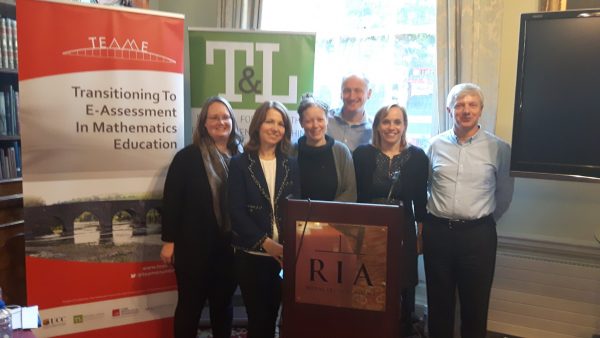
The TEAME (Transitioning to E–Assessment in Mathematics Education) project is a joint initiative between University College Cork (UCC) and Cork Institute of Technology (CIT) project funded by the National Forum for the Enhancement of Teaching and Learning in Higher Education (Ireland) through the Teaching and Learning Enhancement Fund 2014.
The main project aim is to leverage the potential of Numbas to construct localized formative e-assessment for first year service Mathematics and Statistics courses at UCC and CIT. The project focuses on the implementation and evaluation of this mathematics e-assessment tool.
Read the rest
In this series of posts, we’re highlighting questions we’ve found on the public Numbas editor which do something innovative or are of particularly high quality.
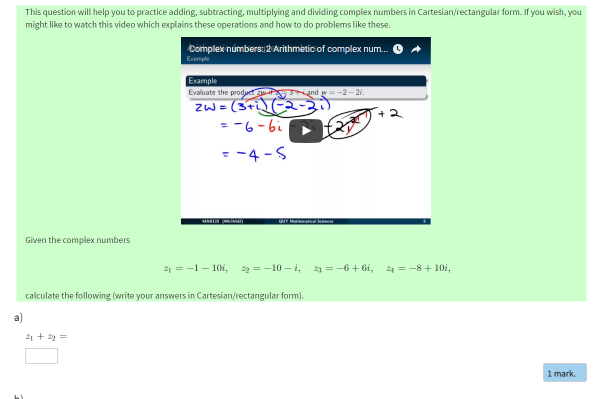
In this question, Dann Mallet of QUT very effectively integrates a video from his course to remind students of the rules of complex arithmetic before testing them on some basic operations.
It’s really easy to include a video in a Numbas question – Dann has uploaded his recording to YouTube, then embedded it in his question statement using the “embed video” button in the editor (there’s a screencast in the online Numbas docs showing exactly how).
We asked Dann how he uses Numbas in his teaching:
I’m the Director of Learning and Teaching for Mathematical Sciences at Queensland University of Technology (Brisbane Australia), as well as teaching students of mathematics, engineering, science and education degrees. Part of my directorial responsibilities is knowing about, testing and encouraging others to use innovative technologies for teaching mathematics. This is how I got onto using Numbas – I’m working to push us from a reliance on WeBWorK to Numbas, which I find to be more friendly to “creative” teachers. So far, I’ve only managed to play around with numbers to give my students some outside of class time activities to work on.
And thanks to Dann for releasing this question under a CC-BY-NC-SA licence, so others can reuse this question freely!
Try this question out now, on the Numbas editor, or have a look at the rest of Dann’s freely-available content.
In this series of posts, we’re highlighting questions we’ve found on the public Numbas editor which do something innovative or are of particularly high quality.
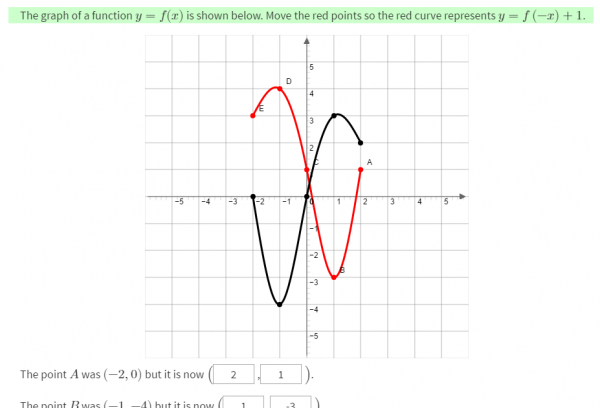
In this question, Ben Brawn of the University of Newcastle, Australia (our namesake down under!) tests your understanding of plane transformations by asking you to move points on a function’s curve corresponding to a given transformation.
I like how this question encourages students to explore their understanding of plane transformations graphically, by dragging points about. They can also work the other way, writing coordinates in the boxes and seeing how that affects the graph. There’s extra information under the “Show steps” button, making great use of the conditional visibility feature to show hints relevant to the particular transformation shown.
We asked Ben how he uses Numbas in his teaching:
I work at the University of Newcastle, Australia in the Centre for Teaching and Learning as a Mathematics Learning Adviser. The select few of us with this title, work with students individually (through a booking system and regular drop in sessions) and in groups (through regular workshops) to help them make sense of mathematical content. We advise students on how to study for courses that involve mathematics, help them see the big picture in their courses and create mathematical learning resources that we feel are useful for students. We also try to work with lecturers to improve courses if we identify issues.
I create practice examples on basic maths topics (eg primary/high school) and share them on a Blackboard site that all the students at our university have access to. This way regardless of what degree they are studying they have access to basic maths practice and help. If they can’t follow the explanations given in the Numbas practice exams then they contact us for further help, either through email, video chat, or in person.
I have also created course specific questions and exams at the request of lecturers that are placed on their own blackboard course sites and these have only ever been used for practice without marks attached. But who knows, maybe one day we will use Numbas for assessment with marks attached.
Ben has produced a huge amount of high-quality questions on basic maths topics, with over 150 released under a CC-BY-NC-SA licence, free for anyone to re-use. Thanks, Ben!
Try this question out now on the Numbas editor, or have a look at Ben’s other freely-available content.

The MathJax team has announced that their free cdn.mathjax.org service, which serves copies of MathJax, will shut down on April 30, 2017 – the end of this month. Numbas uses MathJax to render mathematical notation using LaTeX, and until now the default theme has used cdn.mathjax.org.
This is much less notice than we would’ve liked, but it’s out of our hands. So we need to change how Numbas uses MathJax from now on, and the shutdown has ramifications for existing exam packages.
How Numbas will use MathJax from now on
In short: there’s a new default URL, and you shouldn’t notice any difference. You can configure Numbas to use your own copy of MathJax if you’d prefer.
Read the rest








